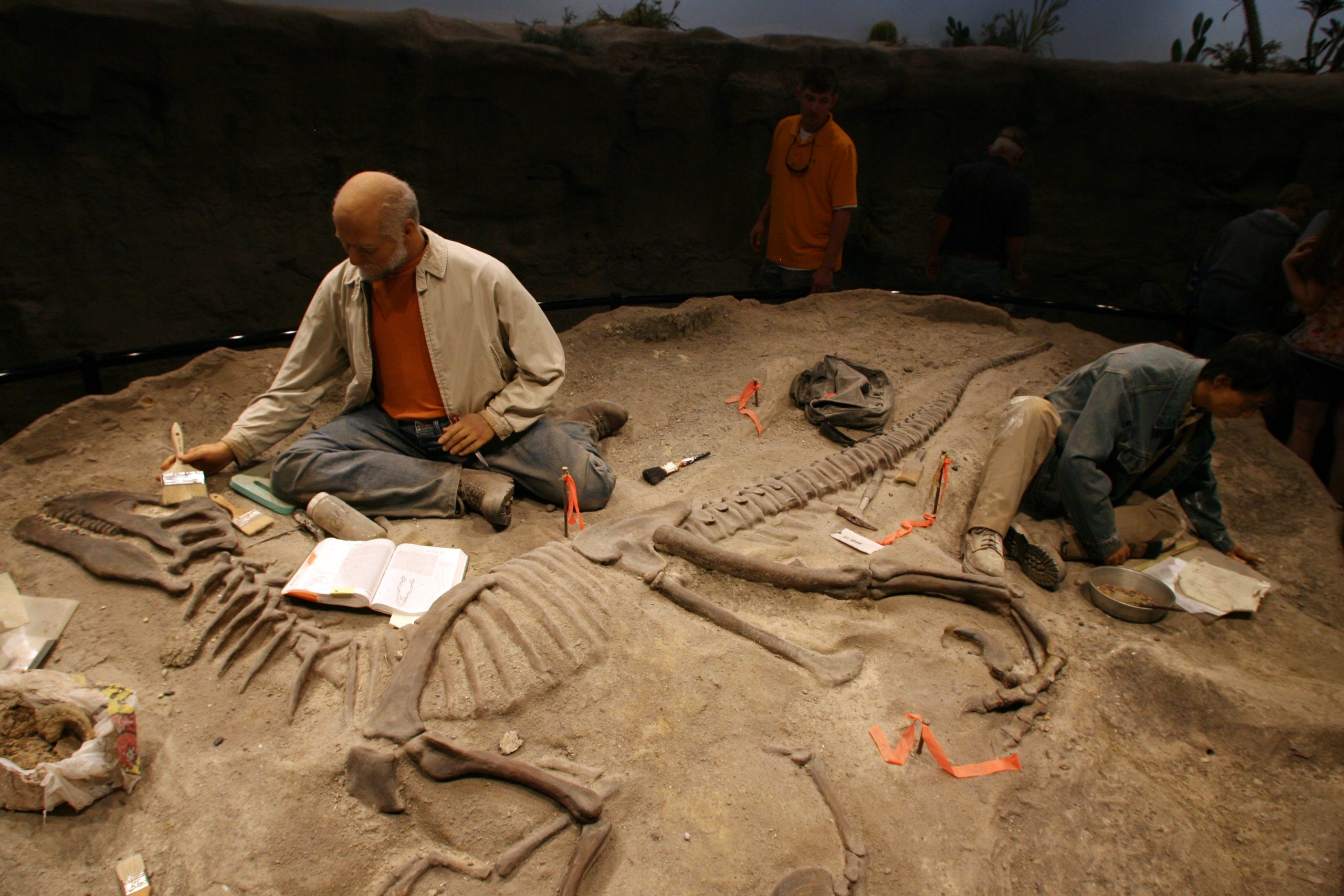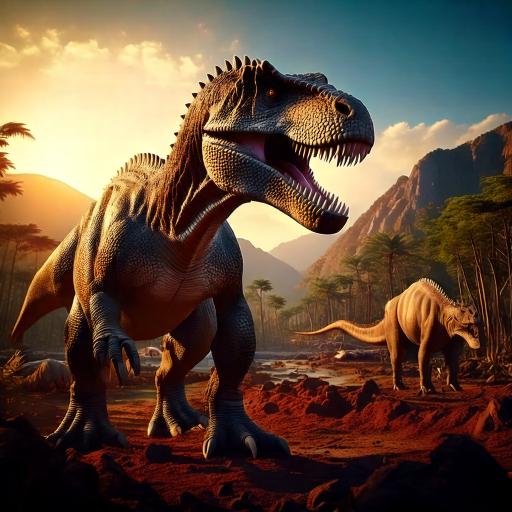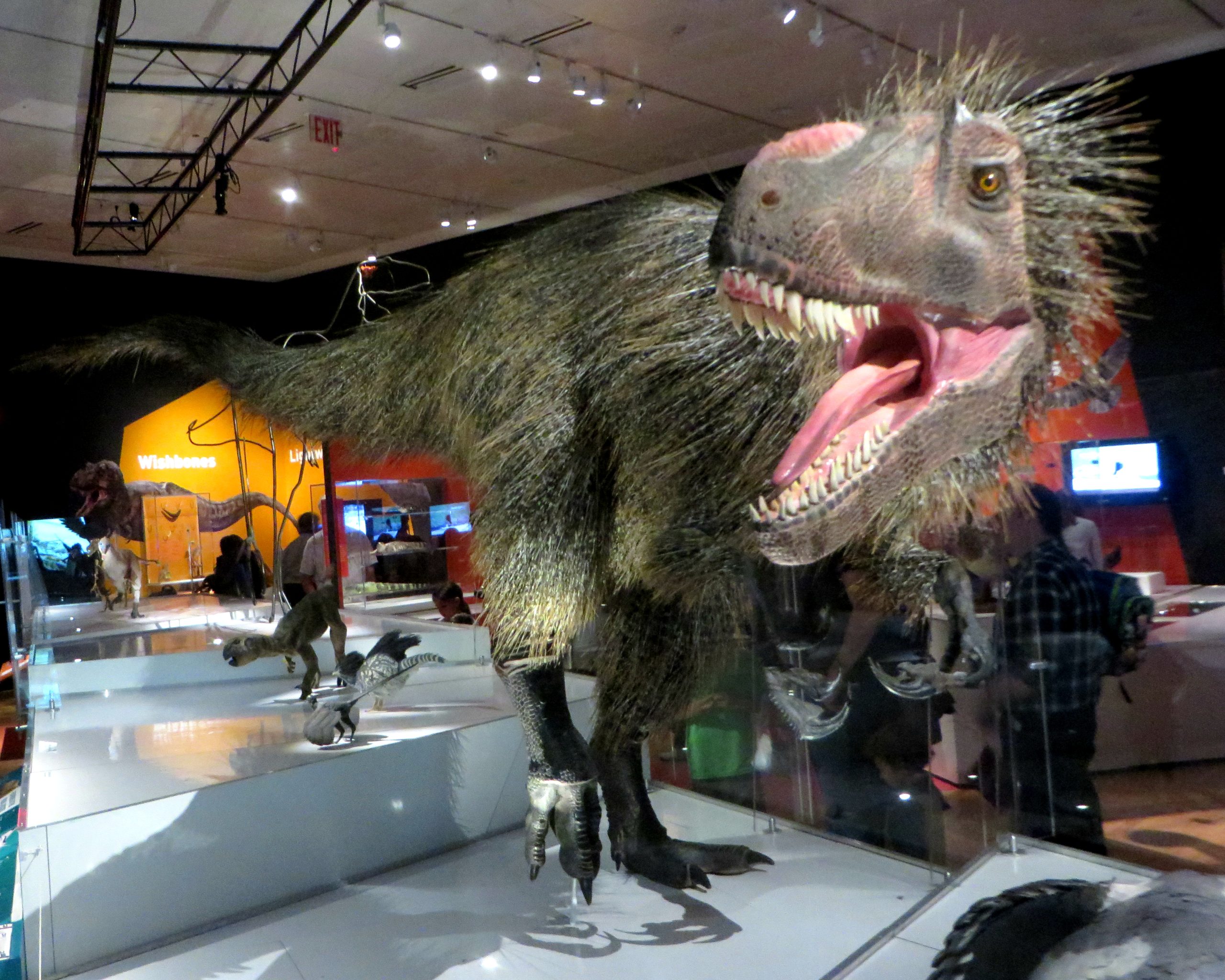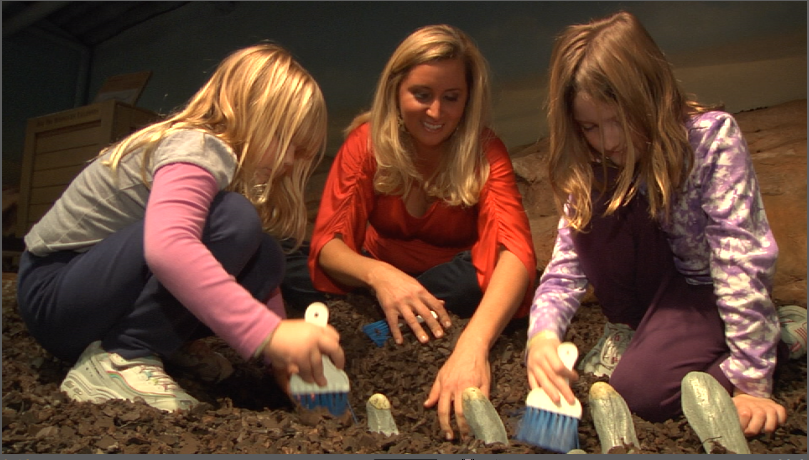Chapter 1: Fossils and their Owners

Warm-Up Questions

- How can we learn about our ancient past?
- How do scientists help us understand history?
- Have you ever read about dinosaurs? What do you know about them?
Read

When you picture a dinosaur, what do you see? A giant monster covered in scales and roaring? A creature ready to chomp down and consume whatever poor person may be standing in their way? The images placed in your head by pop culture and movies may be far from the truth.
To those unfamiliar, dinosaurs ruled Earth during the Mesozoic era, which was a time period from 245 million years ago to 66 million years ago. They were animals that dominated the ecosystem of the entire globe. Though you may think of them as gigantic, they came in all different shapes and sizes; some were only the size of house cats.
As scientists uncover more and more dinosaur fossils, our understanding of dinosaurs grows. Fossils are the remains of animals that lived many years ago. They are formed when bones are covered in sediment, such as sand or mud. As the sediment weighs down on the bones, it creates external pressure and compacts the bones into rock. Water then begins to dissolve the bone and occupy the space until minerals in the water replace the bone entirely, leaving a fossil. There are many things we can learn from fossils, including how old a dinosaur was when it died, how long ago it died, and even what its skin looked like.

Popular culture was right in the assumption that dinosaurs had scaly skin. But as more evidence is unearthed, we learn surprising things. For example, dinosaurs were colourful. By looking at traces of bacteria, reds, greys, and even patterns have been discovered on dinosaur skin. By analyzing fossils, scientists have even determined that some dinosaurs were covered in feathers. This discovery is very important because it implies that dinosaurs are the ancestors of birds.
For a long time, dinosaurs were thought to be the ancestors of lizards, partly because of their name, which comes from the Greek words for terrible and lizard. Scientists now believe that even the most famous dinosaur species, the Tyrannosaurus Rex (T. Rex), had feathers covering a portion of its body. While no fossil evidence of T. Rex feathers has been uncovered, smaller Tyrannosaurs closely related to the T. Rex have been found to have fossilized feathers. The theory is that T. Rex had feathers at birth to conserve warmth but lost the majority of them as it grew older. The ones it kept were thought to be used for mating and display purposes. At birth, T. Rexes were the size of skinny turkeys, but over the course of 20 years, they grew to a height of 3.6-3.9 metres and a weight of 5500-8000 kilograms.

There is still a lot of information we do not know about dinosaurs. For example, scientists still debate about what caused the dinosaurs to go extinct. There is evidence of a large meteor[1] impacting the Earth 66 million years ago, but we do not know about the other factors that occurred during this time period that led to the extinction of so many dinosaurs. There is, however, no shortage of scientists. Every day more and more children are exposed to dinosaurs through movies or video games and are filled with a burning desire to dig through the dirt to see what mysteries they can solve.
Comprehension Questions
Answer the following questions in complete sentences.
- According to the article, are the dinosaurs we see in movies realistic? Why or why not?
- In your own words, what exactly is a fossil?
- Which animals do scientists now consider dinosaurs to be the ancestor of? Why do they believe this?
- How can studying fossils help us understand more about dinosaurs?
- The article talks about fossils from dinosaurs. What are some other fossils that might be found by scientists?
- Fossils can tell us a lot of information about different plants, animals, and people. Other than the ideas mentioned in the article, what else could fossils tell us?
Vocabulary
Analyze
Assumption
Consume
Debate
Dominate
Evidence
External
Factor
Imply
Majority
Occupy
Occurred
Portion
Theory
Trace

Vocabulary Practice
Definitions Exercise
Practise identifying the correct definition for each of the target words.
Parts of Speech Exercise
Read the sentence and guess the part of speech. Turn the card to see if you are correct.
Synonyms Exercise
Drag and drop the synonyms. There are two groups of words.
Fill in the Blanks Exercise
Write in the correct word from the word bank.
Media Attributions
- Love paleontologists by Daniel Incandela is licensed under CC BY-NC 2.0.
- “realistic image of dinosaurs” prompt, Adobe Firefly, 05 Nov. 2024, was artificially generated using Adobe Firefly and is, therefore, shared under CC0 1.0.
- Yutyrannus by Eden, Janine and Jim is licensed under CC BY 2.0.
- Chicago Children’s Museum Dinosaur Expedition Kids by Colleen Kelly is licensed under CC BY 2.0.
References
Adobe. (2024). Adobe Firefly [Image generator].
Arizona State University. (2024). EdPlus Voiceover Generator [Voiceover audio generator].
Branham, M. (n.d.). T-Rex with feathers: The latest discovery in paleontology. Bright Dino.
Microsoft. (2023). Copilot [Large language model].
Natural History Museum. (n.d.). When did dinosaurs live?
Singh Solanki, P. (2023, September 7). Journey of fossils: How are fossils formed and discovered. Geology with Fun.
Weisberger, M. (2019, March 6). Baby T. rex was an adorable ball of fluff. Live Science.
Artificial Intelligence Disclosure
- Microsoft Copilot was used as a brainstorming tool for the activities in this chapter.
- Adobe Firefly was used to generate a realistic image of a dinosaur used in this chapter.
- The Arizona State University EdPlus Voiceover Generator was used to create the audio recording of the reading, vocabulary words, and parts of speech exercise. Adaptations include modification of speed and/or timing, and comping of output takes.
- meteor: a piece of rock or metal that travels through space, and makes a bright line in the night sky when it falls down towards the Earth ↵
Consume - view the definition in the Longman Dictionary of Contemporary English Online [New Tab]
Dominate- view the definition in the Longman Dictionary of Contemporary English Online [New Tab]
External- view the definition in the Longman Dictionary of Contemporary English Online [New Tab]
Occupy- view the definition in the Longman Dictionary of Contemporary English Online [New Tab]
Assumption- view the definition in the Longman Dictionary of Contemporary English Online [New Tab]
Evidence- view the definition in the Longman Dictionary of Contemporary English Online [New Tab]
Trace- view the definition in the Longman Dictionary of Contemporary English Online [New Tab]
Analyze- view the definition in the Longman Dictionary of Contemporary English Online [New Tab]
Imply- view the definition in the Longman Dictionary of Contemporary English Online [New Tab]
Portion- view the definition in the Longman Dictionary of Contemporary English Online [New Tab]
Theory- view the definition in the Longman Dictionary of Contemporary English Online [New Tab]
Majority- view the definition in the Longman Dictionary of Contemporary English Online [New Tab]
Debate- view the definition in the Longman Dictionary of Contemporary English Online [New Tab]
Factor- view the definition in the Longman Dictionary of Contemporary English Online [New Tab]
Occurred- view the definition in the Longman Dictionary of Contemporary English Online [New Tab]

